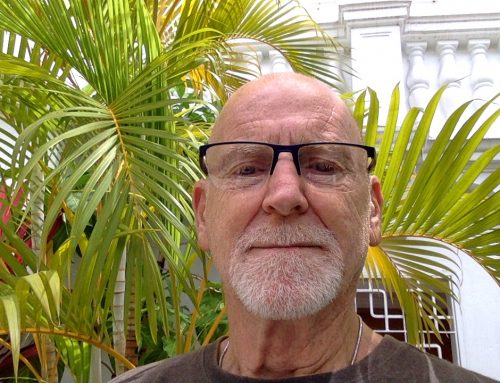On the 8th December 2013, after a huge row which had escalated from the (fairly unremarkable) incident of me switching off the oven with my foot, I left home at 2am with no coat, no money and no hope. Later that night, I was found doubled over on the pavement, choking on my own tears, wondering desperately how I could get the means to kill myself. I had become nothing but a tortured burden who was destroying everything. My family couldn’t stand me, I’d lost friends, I couldn’t do my job, every small task was complicated and exhausting, and I hated myself deeply.
My journey to this moment started five years earlier. Not with a major event or disaster, but with something so commonplace it happens to all of us 50,000-70,000 times per day.
I had a thought.
That’s all. Yet it was so terrifying that I have since termed it, ‘the thought that ruined my life’ because from then on life did change. I started getting more and more thoughts, each one more horrible and frightening than the last, until that night when self-loathing, fear and exhaustion finally overpowered me. The thoughts were taking up all my energy. If I wasn’t having them, I was planning for them and I spent my entire life trying to prevent or neutralise them. But it was hopeless, because wherever I went my thoughts came with me and I was living life on a tightrope, suspended over all their awful possibilities.
You may be reading this wondering ‘what was this thought; why did it have such malevolent power?’ The answer to the first question doesn’t really matter. And the answer to the second is simple: I have OCD. Writing that as an explanation feels inadequate even to me. The colloquial use of the phrase has robbed it of its weight, but what is OCD, really?
In simple terms, an ‘obsession’ is an unwanted thought, fear or urge which causes distress to the person having it. Obsessions are often referred to as intrusions because they’re uninvited, unwanted and unpredictable. A ‘compulsion’ is an act or ritual performed to try and rid oneself of the obsession, or alleviate the anxiety it causes. Hence the term ‘Obsessive Compulsive Disorder.’
OCD can take many forms, but is always characterised by obsessions, compulsions and distress. In no particular order, here are some examples of obsessions and the types of compulsions they might lead to:
“Did I run someone over earlier?” Those who obsess that they have hurt someone whilst driving might spend hours replaying the journey in their minds, retracing the journey to check for signs of an accident or checking the local news.
“Did I lock the door?” Such doubts can lead to checking and rechecking or avoiding leaving the house altogether.
“Am I a paedophile?” This is a common concern among OCD sufferers. Compulsions include avoiding children, reassurance seeking and confessing.
“What if I get ill?” When people obsess about health, compulsions might involve Googling symptoms, seeking reassurance or going to great lengths to avoid contamination.
While these are common obsessions, an obsession can actually be about anything. Years ago, I obsessed that I was a hermaphrodite. Having attended a support group for 3 years, I’ve not only met someone who shared this obsession, but heard all kinds of others from, ‘I fear my father will rape me’ to ‘what if I’ve cheated on my partner and forgotten?’ to ‘I was terrified I’d violently kill my children’. (It’s important to point out that people whose obsessions focus on causing harm to others are the last people to do such a thing; the reason they find these intrusions so distressing is because they’re so completely at odds with their values.) It’s not the content of the obsession that determines whether it’s OCD or not, but the distress and subsequent habits. In fact, nearly everyone has intrusions and OCD sufferers’ do not differ from anyone else’s. What differs is the upset they cause. Similarly, a compulsion isn’t always something obvious; often checking or ritualising takes place purely in the sufferer’s mind. Rumination, neutralising and reassurance seeking are also compulsions.
For me, OCD began when I was five, when I started feeling like I had to ‘balance out’ sensations on the left and right hand side of my body. I didn’t know why I was doing it, just that I felt uncomfortable if I didn’t. Then when I was six, I heard the phrase ‘if you worry about it, it will never happen’. Unfortunately, I took this literally and began to worry as often and as fervently as possible about my family dying because surely if I didn’t, then they would. Next, I started to worry excessively that inanimate objects had feelings and I might have hurt them. As a teenager I was so concerned that I might be the next Virgin Mary that I was probably the only teenager who entertained the idea of losing my virginity to avoid pregnancy.
However, it was when I was 22 that the bully really took over; I became convinced that I was a really, really bad person. That thought I mentioned before (the one which ruined my life) was about stabbing someone I cared about. I was so deeply shocked and distressed by it that all I could think to do was get rid of it. But intrusions don’t work that way because the more you try not to think something, the more you think about it. Soon I was worried about hurting everyone and I didn’t trust myself anywhere. On a train platform? ‘Jump.’ Sending a text? ‘Perhaps I’m sending a nude photograph.’ Walking past a school? ‘Assault that child.’ My great uncle died. ‘Did I do that?’
You’ll be pleased to know, I didn’t do any of those things. But the thoughts were relentless and each one shattered me anew, until I felt I was poisonous and could somehow spread my nastiness. Even after wrapping presents, I was tormented by the idea that when they were opened the recipients would die. What’s more, I became frightened of anything which might morally contaminate me even further. Anything from newspapers, with their stories of iniquity, to door handles, which had been touched by strangers, had the potential to turn me into what I most feared.
It would take forever to list every obsession and compulsion I’ve had, because any unpleasant notion which enters my head has the potential to become an obsession and so many of them have. Since learning more about OCD, I’ve realised that this isn’t because I’m delusional or dangerous, but because for as long as I can remember I wouldn’t leave my thoughts alone. I picked at every worry, doubt, risk and fear like they were scabs until they bled into every part of my life. It was this reaction which was ruining me, not the thoughts themselves.
Through Cognitive Behavioural Therapy, I learnt to accept the thoughts for what they were and treat them as ‘unwanted party guests’ – allowing them to be there without engaging with them. This involved confronting them, full on, and I couldn’t have done it without the unwavering faith and support of a phenomenal therapist. I’m not OCD free now, but I can do so many things I couldn’t before, OCD no longer dictates my life and I’m not scared all the time.
I wrote this for two kinds of people: those who don’t know much about OCD, and those who know too much. If you fall into the first category, I hope I have shown you that behind OCD’s public persona – that of the ‘quirky’ personality trait – lies a dark and very real illness. As for the people in the second category, already horribly familiar with the condition because you’re on the inside of it: I want you to feel like it’s OK to talk about what frightens you, to know that you can get better, that you’ve nothing to be ashamed of and, crucially, realise that you’re not alone. Thanks for reading.
* * *
 Eve is 28 and lives in the UK. She loves travel, cooking, reading, cocktails and writing. She works in education, is a freelance writer, volunteers for an OCD charity and blogs about OCD (and other things) at: www.avonlea-and-amulets.blogspot.co.uk.
Eve is 28 and lives in the UK. She loves travel, cooking, reading, cocktails and writing. She works in education, is a freelance writer, volunteers for an OCD charity and blogs about OCD (and other things) at: www.avonlea-and-amulets.blogspot.co.uk.
Eve can be found on her blog and Twitter.
If you enjoyed this post, please take a few moments to leave a comment or to share with your friends using the little share buttons below.








Leave A Comment